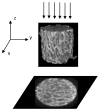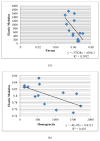THE MEASUREMENT OF BONE QUALITY USING GRAY LEVEL CO-OCCURRENCE MATRIX TEXTURAL FEATURES
- PMID: 28042512
- PMCID: PMC5198780
- DOI: 10.1166/jmihi.2016.1812
THE MEASUREMENT OF BONE QUALITY USING GRAY LEVEL CO-OCCURRENCE MATRIX TEXTURAL FEATURES
Abstract
In this paper, statistical methods for the estimation of bone quality to predict the risk of fracture are reported. Bone mineral density and bone architecture properties are the main contributors of bone quality. Dual-energy X-ray Absorptiometry (DXA) is the traditional clinical measurement technique for bone mineral density, but does not include architectural information to enhance the prediction of bone fragility. Other modalities are not practical due to cost and access considerations. This study investigates statistical parameters based on the Gray Level Co-occurrence Matrix (GLCM) extracted from two-dimensional projection images and explores links with architectural properties and bone mechanics. Data analysis was conducted on Micro-CT images of 13 trabecular bones (with an in-plane spatial resolution of about 50μm). Ground truth data for bone volume fraction (BV/TV), bone strength and modulus were available based on complex 3D analysis and mechanical tests. Correlation between the statistical parameters and biomechanical test results was studied using regression analysis. The results showed Cluster-Shade was strongly correlated with the microarchitecture of the trabecular bone and related to mechanical properties. Once the principle thesis of utilizing second-order statistics is established, it can be extended to other modalities, providing cost and convenience advantages for patients and doctors.
Keywords: DXA; GLCM; bone; medical imaging; osteoporosis; texture.
Conflict of interest statement
Conflict of Interests The authors declare that there are no conflicts of interest regarding the publication of this paper.
Figures







Similar articles
-
High-resolution magnetic resonance imaging: three-dimensional trabecular bone architecture and biomechanical properties.Bone. 1998 May;22(5):445-54. doi: 10.1016/s8756-3282(98)00030-1. Bone. 1998. PMID: 9600777
-
In vivo assessment of architecture and micro-finite element analysis derived indices of mechanical properties of trabecular bone in the radius.Osteoporos Int. 2002 Jan;13(1):6-17. doi: 10.1007/s198-002-8332-0. Osteoporos Int. 2002. PMID: 11878456
-
Failure strength of human vertebrae: prediction using bone mineral density measured by DXA and bone volume by micro-CT.Bone. 2012 Jun;50(6):1416-25. doi: 10.1016/j.bone.2012.03.002. Epub 2012 Mar 10. Bone. 2012. PMID: 22430313
-
A review of magnetic resonance (MR) imaging of trabecular bone micro-architecture: contribution to the prediction of biomechanical properties and fracture prevalence.Technol Health Care. 1998 Dec;6(5-6):321-7. Technol Health Care. 1998. PMID: 10100935 Review.
-
Use of dual energy X-ray absorptiometry, the trabecular bone score and quantitative computed tomography in the evaluation of chronic kidney disease-mineral and bone disorders.Nephrology (Carlton). 2017 Mar;22 Suppl 2:19-21. doi: 10.1111/nep.13016. Nephrology (Carlton). 2017. PMID: 28429557 Review.
Cited by
-
Prediction of soft tissue sarcoma grading using intratumoral habitats and a peritumoral radiomics nomogram: a multi-center preliminary study.Front Oncol. 2024 Dec 11;14:1433196. doi: 10.3389/fonc.2024.1433196. eCollection 2024. Front Oncol. 2024. PMID: 39723369 Free PMC article.
-
Quantitative Evaluation of the Effectiveness of Chemical Peelings in Reducing Acne Lesions Based on Gray-Level Co-Occurrence Matrix (GLCM).Clin Cosmet Investig Dermatol. 2022 Sep 12;15:1873-1882. doi: 10.2147/CCID.S375131. eCollection 2022. Clin Cosmet Investig Dermatol. 2022. PMID: 36117771 Free PMC article.
-
An Automatic Classification Method on Chronic Venous Insufficiency Images.Sci Rep. 2018 Dec 18;8(1):17952. doi: 10.1038/s41598-018-36284-5. Sci Rep. 2018. PMID: 30560945 Free PMC article.
-
Texture Parameters Measured by UHF-MRI and CT Scan Provide Information on Bone Quality in Addition to BMD: A Biomechanical Ex Vivo Study.Diagnostics (Basel). 2022 Dec 13;12(12):3143. doi: 10.3390/diagnostics12123143. Diagnostics (Basel). 2022. PMID: 36553150 Free PMC article.
-
3D bone texture analysis as a potential predictor of radiation-induced insufficiency fractures.Quant Imaging Med Surg. 2018 Feb;8(1):14-24. doi: 10.21037/qims.2018.02.01. Quant Imaging Med Surg. 2018. PMID: 29541619 Free PMC article.
References
-
- Turner C, Rho J, Ashman R, Cowin S. The dependence of elastic constants of cancellous bone upon structural density and fabric. Trans Orthopaed Res Soc. 1988;13:74.
-
- Luo G, Kinney J, Kaufman J, Haupt D, Chiabrera A, Siffert R. Relationship between plain radiographic patterns and three-dimensional trabecular architecture in the human calcaneus. Osteoporosis international. 1999;9:339–345. - PubMed
-
- Benhamou C, Lespessailles E, Jacquet G, Harba R, Jennane R, Loussot T, Tourliere D, Ohley W. Fractal organization of trabecular bone images on calcaneus radiographs. Journal of bone and mineral research. 1994;9:1909–1918. - PubMed
-
- Chappard D, Chennebault A, Moreau M, Legrand E, Audran M, Basle M. Texture analysis of X-ray radiographs is a more reliable descriptor of bone loss than mineral content in a rat model of localized disuse induced by the Clostridium botulinum toxin. Bone. 2001;28:72–79. - PubMed
Grants and funding
LinkOut - more resources
Full Text Sources
Other Literature Sources
